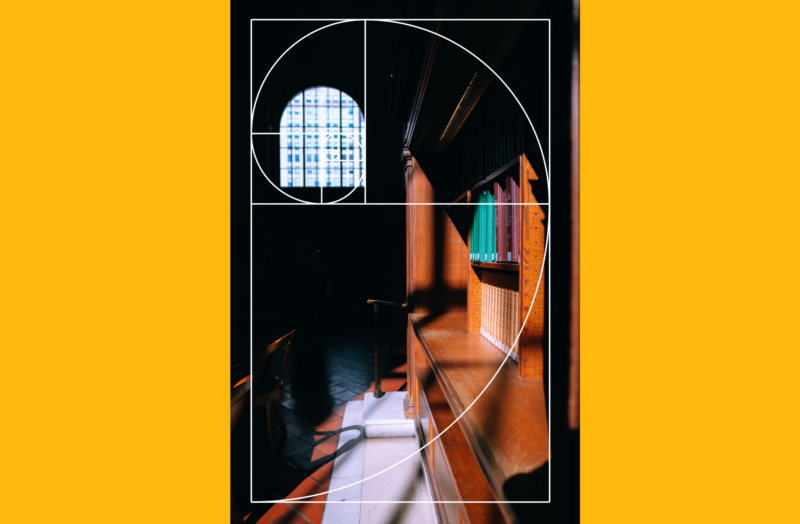If you’re ready to grow as a photographer using a composition technique that is tricky to apply but worth mastering, it’s time to start experimenting with the golden ratio. The golden ratio can be applied to your compositions in many different ways, with the goal of creating a naturally striking composition.
Never heard of the golden ratio? Perhaps you know it by one of its many aliases: the golden mean, phi grid, Fibonacci spiral, or the divine proportion. Call it what you want, but be sure to give this technique a try to improve your compositions.


What is the golden ratio in photography?
You’ve already learned that the golden ratio is a composition guide, but did you know that the basis for the golden ratio is mathematics? But don’t worry; you won’t need to solve any equations to use this technique!
The golden ratio is a ratio of approximately 1.618 to 1. It has been used for centuries by artists, architects, and musicians, but it can also be found everywhere in the natural world. To use the golden ratio in photography, you simply apply it to the placement of objects in your composition. We’ll talk more about the specific ways you can apply the golden ratio to your photos below.
Why is it called the golden ratio?
The golden ratio is extraordinary because it can be visualized in every aspect of life, from the human body to famous works of art and everything in between. Although this mathematical existed independently of humankind long before recorded history, artists started using it as a basis for compositions in the 1500s. Renaissance artists began calling it the golden ratio or the divine proportion because of its ability to achieve balance and beauty.
The Fibonacci spiral

The Fibonacci spiral is based on the Fibonacci sequence, which was discovered by Leonardo Fibonacci around the year 1200. This is a sequence of numbers that begins with 0 and 1. Add the two together to get 1. Each number in the sequence is the sum of the two numbers that precede it. So, the sequence goes: 0, 1, 1, 2, 3, 5, 8, 13, 21, 34, and on and on.
The ratio of any two successive Fibonacci numbers is very close to the golden ratio, which is approximately 1.618034. And if you use Fibonacci numbers to create a grid with squares representing the width of Fibonacci numbers, you end up with the Fibonacci spiral.
The phi grid
The phi grid is another way to visualize the golden ratio. Rectangles can be superimposed over an image in a grid based on the 1:1.618 ratio. This “phi grid” divides your scene into thirds, both horizontally and vertically. But unlike the more popular rule of thirds, the center lines in the Phi Grid are closer together. This moves the more important elements of your photo closer to the center.
How is the golden ratio better than the rule of thirds?
The rule of thirds is basically a simplification of the golden ratio. It is very easy to visualize and, therefore, easier for novice photographers to use without much forethought. The golden ratio, by contrast, is a bit more technical. In this scenario, you are dealing with more precise ratios, so it’s not as easy to align your composition. Using the golden ratio in photography is useful for leading the viewer’s eyes around your image in a way that is naturally striking and balanced.
What you choose to use for a given composition will depend a lot on the scene you are trying to capture. The rule of thirds is great for minimalist photographs where you have a single subject. The golden ratio is useful for positioning several objects in a composition or to emphasize movement.
How to use the golden ratio in your iPhone photography
Now it’s time to use the golden ratio to create your own compositions. Here are some ideas and tips for composing your photos using the golden ratio with your iPhone. It takes practice, but eventually, you will start to see the grid lines in your mind’s eye when you frame a shot.
How to compose for the golden ratio
The golden ratio can be applied to many different scenes using the phi grid or the Fibonacci spiral. How do you know which one to use?
Look for leading lines or natural curves within the scene. Strong leading lines are best placed using the phi grid, and curved, organic lines work better with the Fibonacci spiral. The rule of thirds is a simplified version of the golden ratio, so if you are having trouble imagining the grid overlay when framing your shot, don’t be afraid to use the rule of thirds.
If you don’t have the rule of thirds grid overlay activated on your iPhone camera, you can turn it on in Settings. Simply navigate to Settings > Camera > Grid and toggle it on. Trying to imagine a Fibonacci spiral aligned over your photo is difficult at first but gets easier over time.
If you’re using the Fibonacci spiral, place your subject farther out than the rule of thirds intersection. If you chose the phi grid, place your subject closer to the center of the image compared to the rule of thirds intersection.
Try shooting from different vantage points to emphasize the golden ratio. You may have to crouch down or shoot from above your head. If you’re unsure of which composition works best, take lots of images and then use an editing program to crop them later.
How to use the golden ratio crop in Lightroom
Do you use the Lightroom app on your iPhone? You can use a variety of grid overlays when using the Lightroom camera, including the rule of thirds and the phi grid. When in the camera view, tap the three dots in the upper right to enable this option.
To use the golden ratio crop during post-processing, you will have to use the desktop version of Lightroom. As an aside, we hope that they will eventually add this feature to Lightroom Mobile. But in the meantime, here’s how to crop your photo using the golden ratio with Lightroom on your computer:
- Open Lightroom on your computer and switch to Developer Mode.
- Click the crop button on the left toolbar to open the crop tool.
- Use the “O” key to cycle through the different crop overlays. You will see the rule of thirds grid, the phi grid, and the Fibonacci spiral, along with several others.
- Use whichever grid overlay you’ve chosen to set guidelines for what to crop.
- When you are happy with the results, export your photo to your files or Airdrop it back to your iPhone.

Using the golden ratio in photography will help you elevate your composition techniques and make you a better photographer. Although it’s difficult to learn, once you start using the golden ratio to compose your images, you’ll be hooked!



